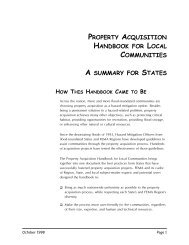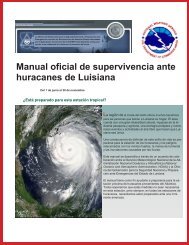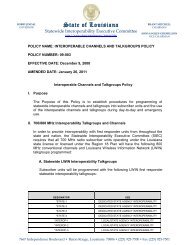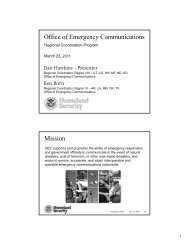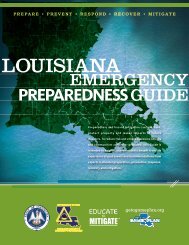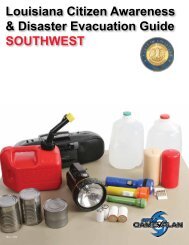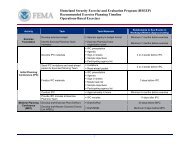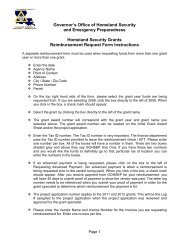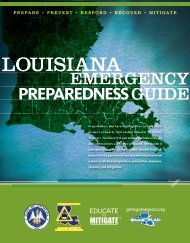Before the Federal Communications Commission Washington, D.C. ...
Before the Federal Communications Commission Washington, D.C. ...
Before the Federal Communications Commission Washington, D.C. ...
- No tags were found...
You also want an ePaper? Increase the reach of your titles
YUMPU automatically turns print PDFs into web optimized ePapers that Google loves.
<strong>Federal</strong> <strong>Communications</strong> <strong>Commission</strong> FCC 02-64manufacturers and <strong>the</strong>refore will not require that newly manufactured equipment be capable of receivingand transmitting <strong>the</strong>se new event codes until August 1, 2003. Thus, all existing and new models of EASequipment manufactured after August 1, 2003 will be required to be capable of receiving andtransmitting <strong>the</strong>se codes. We believe that this approach is preferable for several reasons.14. First, participation in EAS at <strong>the</strong> state and local levels has been voluntary since we firstauthorized its use for state and local emergencies in 1976. 37 Despite <strong>the</strong> fact that participation in stateand local EAS is voluntary, broadcast stations and cable systems have participated extensively in stateand local EAS activities and have helped to make EAS an invaluable tool for disseminating informationabout state and local emergencies to <strong>the</strong> public. We fully expect that broadcast stations and cablesystems will continue to be active participants in <strong>the</strong>ir state and local EAS plans and we stronglyencourage <strong>the</strong>m to upgrade <strong>the</strong>ir existing equipment and begin using <strong>the</strong> new codes without delay. Wethink, however, that it would be contrary to <strong>the</strong> voluntary nature of state and local EAS to mandateupgrades to existing EAS equipment to incorporate new optional event codes.15. In addition, we are concerned that imposing additional costs and burdens on broadcaststations and cable systems at this time may have <strong>the</strong> undesired effect of reducing voluntary participationin state and local EAS activities. The commenters confirm that implementation of <strong>the</strong> new codes willnecessitate software/firmware and, in some cases, hardware upgrades to existing equipment. 38 Twoequipment manufacturers which filed comments estimate that such upgrades will cost from $100 to $300plus shipping and handling. 39 While <strong>the</strong>se costs may seem relatively modest, we recognize that <strong>the</strong>y maypresent a financial burden to some broadcast stations, particularly radio stations in smaller markets. 40Fur<strong>the</strong>rmore, it appears that <strong>the</strong> costs of upgrades for cable systems may be significantly higher. In thisregard, NCTA estimates, based on discussions with equipment manufacturers, that <strong>the</strong> cost for cablesystems to upgrade <strong>the</strong>ir equipment would be $200 to $500 plus labor and <strong>the</strong> administrative costs ofinstalling <strong>the</strong> upgrades in each and every headend. 41 NCTA fur<strong>the</strong>r observes that for cable systems thisadditional expense would come only three years after making substantial expenditures to purchase andinstall new EAS equipment. 42 Similarly, <strong>the</strong> National Association of Broadcasters (“NAB”) points outthat it has only been about five years since broadcast stations made substantial investments in new EASequipment. 43 Several commenters predict that <strong>the</strong> costs and burdens associated with a requirement toretrofit existing equipment to implement <strong>the</strong> new codes would cause some broadcast stations and cable37In 1976, <strong>the</strong> FCC, NWS, <strong>the</strong> Defense Civil Preparedness Agency and <strong>the</strong> National Industry AdvisoryCommittee (“NIAC”) approved a plan for <strong>the</strong> use of <strong>the</strong> former EBS for state and local emergencies. See Plan forNationwide Use of <strong>the</strong> Emergency Broadcast System for State and Local Emergencies (June 28, 1976). This planwas revised in 1982 pursuant to a Memorandum of Understanding between <strong>the</strong> FCC, <strong>the</strong> <strong>Federal</strong> EmergencyManagement Agency, NWS and NIAC. See Memorandum of Understanding on State and Local EmergencyBroadcasting System (April 21, 1982).38Gorman Comments at 1; TFT Comments at 3; NCTA Comments at 4.39Gorman Comments at 1; TFT Comments at 3. These estimates include <strong>the</strong> cost of upgrading EASequipment to revise existing codes and to add new codes.40414243See KPVI Comments at 1; Seven Ranges Comments at 11; NAB Comments at 4.NCTA Comments at 4.Id.NAB Comments at 8.8




